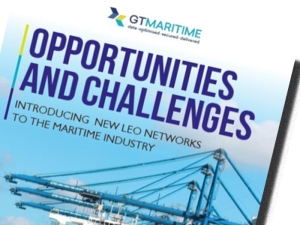


(Posted on 09/08/23)
GTMaritime, leading experts in secure maritime data communications solutions, has released a new whitepaper that assesses the impact Low Earth Orbit (LEO) networks are having on the maritime industry and key considerations for wider adoption.
Available to download free of charge, Opportunities and Challenges: Introducing New LEO Networks to the Maritime Industry, offers an insightful overview of commercial shipping’s first movers in LEO network service use. It outlines the potential for positive impact of LEO network bandwidth on vessel operations and describes a “quantum leap for crew connectivity possibilities”.
However, the thoughtful paper also explores the challenges of integrating LEO network services that do not offer global coverage into shipping’s existing global connectivity infrastructure. In a tightly regulated industry, it also gives due consideration to the fact that existing networks support mandatory GMDSS connectivity.
Richard White, Global Commercial Director at GTMaritime, said: “The introduction of LEO networks is a massive step forward for maritime communications and connectivity. The expectations are understandably high, as is the interest around how the addition of these constellations could transform maritime communications for the better. However, it’s important to recognise that LEO networks on their own would struggle to sustain the communication demands of modern shipping and that a more realistic approach focusing on integration with current infrastructure and solutions is required.”
Key sections of the new whitepaper consider the connectivity and cyber security imperatives, if LEO networks are to be integrated with existing solutions, highlighting how vessels must have systems in place to prevent disruption when switching between satellites or providers. The paper concludes with specific questions that need answering when considering the use of LEO networks and offers guidance on issues including the risks of bandwidth reduction and the benefits of data compression.
“Our new whitepaper offers insights into the challenges and opportunities faced by owners and operators as they assess whether and how to use LEO networks as part of their ship-to-shore connectivity. To help them in their considerations, it provides straightforward guidance on the critical issues affecting ship operations, crew connectivity and systems interoperability,” added Richard.
Bruks Siwertell Group has announced a leadership transition as Peter Jonsson steps down as CEO after... Read more
ClassNK has issued an approval in principle (AiP) for a Rigid Windsail Type Wind-Assisted Propulsion... Read more
Elcome International’s new high-speed internet service, WELCOME, is revolutionising the way ship... Read more
Kaiko Systems, a leader in AI-driven frontline intelligence for the maritime industry, today announced... Read more
Marcegaglia’s latest acquisition, the LHM 600, marks a significant milestone as the 2,000th mobile... Read more
The Isle of Man Ship Registry (IOMSR) is playing a key role in the development of a high-tech sail aimed... Read more
AtoB@C Shipping, subsidiary of ESL Shipping, has taken delivery of Terramar in Goa, India on 14 March... Read more
As a new strategy period commences, VIKING Life-Saving Equipment A/S has achieved strong financial results... Read more
Baltic Exchange has introduced a series of green fuel options to its FuelEU voyage and compliance cost... Read more
Veson Nautical, a global leader in maritime data and freight management solutions, and Cargill have... Read more